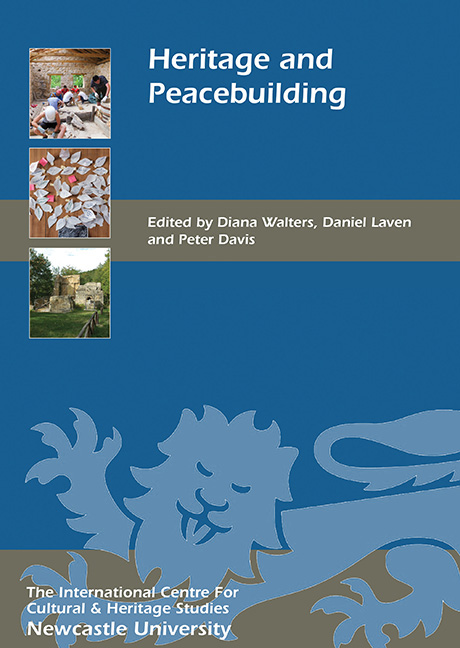Book contents
- Frontmatter
- Contents
- List of illustrations
- Acknowledgements
- List of abbreviations
- Preface
- Introduction
- NEW AND EMERGING IDEAS AROUND HERITAGE AND PEACE
- HERITAGE AND PEACEBUILDING IN PRACTICE
- 7 A Conversation with Sultan Somjee: Conflict and Peacebuilding in Kenya
- 8 Museum, Peace and Reconciliation: the Impact of the Balkan Museum Network
- 9 Diversity, Leadership and Peacebuilding in Museums in the Western Balkans
- 10 Disturbing the Peace: Museums, Democracy and Conflict Avoidance
- 11 Transforming Conflict Through Peace Cultures
- 12 Rethinking Heritage from Peace: Reflections from the Palestinian–Israeli Context
- 13 A Conversation with Will Glendinning: Diversity Challenges in Northern Ireland
- HERITAGE, PEACEBUILDING AND SITES
- List of Contributors
- Index
- Previous Titles
11 - Transforming Conflict Through Peace Cultures
from HERITAGE AND PEACEBUILDING IN PRACTICE
Published online by Cambridge University Press: 16 February 2018
- Frontmatter
- Contents
- List of illustrations
- Acknowledgements
- List of abbreviations
- Preface
- Introduction
- NEW AND EMERGING IDEAS AROUND HERITAGE AND PEACE
- HERITAGE AND PEACEBUILDING IN PRACTICE
- 7 A Conversation with Sultan Somjee: Conflict and Peacebuilding in Kenya
- 8 Museum, Peace and Reconciliation: the Impact of the Balkan Museum Network
- 9 Diversity, Leadership and Peacebuilding in Museums in the Western Balkans
- 10 Disturbing the Peace: Museums, Democracy and Conflict Avoidance
- 11 Transforming Conflict Through Peace Cultures
- 12 Rethinking Heritage from Peace: Reflections from the Palestinian–Israeli Context
- 13 A Conversation with Will Glendinning: Diversity Challenges in Northern Ireland
- HERITAGE, PEACEBUILDING AND SITES
- List of Contributors
- Index
- Previous Titles
Summary
Cultural heritage, both tangible and intangible, is an invaluable resource that can be mobilised as assets for ‘livelihoods, democratization, truth telling, peacebuilding, nationhood and identity’ (Hughes 2011). Throughout the colonial and post-colonial era in Kenya communities have continued to use heritage for peacebuilding and conflict transformation. Nonetheless, this heritage continues to suffer from a lack of acceptance by the majority of the Kenyan population, especially the educated and those who have embraced modern faiths. This has contributed to suppression, erasure and a loss of peace heritage. Globalisation has not spared this heritage either. It has led to a rising demand for land, iron ore and wood for fuel, construction and carving materials. As a consequence, many sacred sites have been sold or turned into commercial sites, hence denying the rest of the community an opportunity to benefit from this heritage. However, there is a renaissance aimed at reclaiming and preserving this heritage in Kenya and community peace museums are among the organisations spearheading this initiative. The museums aim to give exposure to African peace heritage and to facilitate community access to this heritage and its management.
This chapter looks at the development of community peace museums in Kenya. First, the development of the peace museums is outlined. Then the peace museums’ definition of peace is discussed and how the museums make this abstract philosophical concept materialise into a tangible peace museum is described. This is followed by an illustration of how the peace museums use this heritage in conflict transformation. A discussion of how this heritage is being eroded and suppressed follows. The chapter concludes by looking at hopes and promises in heritage management in Kenya.
COMMUNITY PEACE MUSEUMS, KENYA
Community peace museums are a recent phenomenon in Kenya. They are privately funded and were initiated in the mid-1990s by Kenyan ethnographer Dr Sultan Somjee as a material culture project sponsored by the Mennonite Central Committee of Kenya. There are two main objectives of the community peace museums. These are to give exposure to African peace heritage and to facilitate community access to resources and management of traditional peace materials. The museums have become important repositories of knowledge on peace cultures in Kenya.
- Type
- Chapter
- Information
- Heritage and Peacebuilding , pp. 127 - 136Publisher: Boydell & BrewerPrint publication year: 2017



